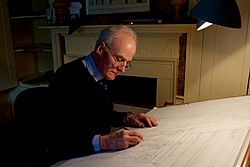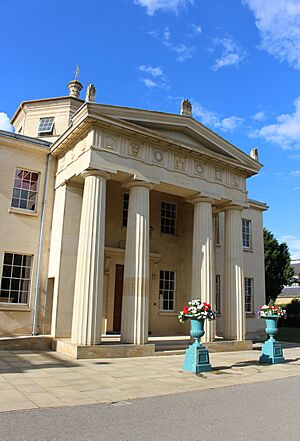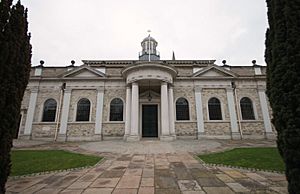Quinlan Terry facts for kids
Quick facts for kids
Quinlan Terry
|
|
|---|---|

Quinlan Terry in 2018
|
|
| Born |
John Quinlan Terry
24 July 1937 |
| Occupation | Architect |
| Spouse(s) | Christina de Ruttié |
| Children | 5, including Francis Terry |
| Practice | Quinlan Terry Architects |
| Buildings | The Maitland Robinson Library, Downing College, Cambridge Brentwood Cathedral addition Regent's Park villas Richmond Riverside Development |
| Projects | 10 Downing Street, London, England. (1980’s interior refurbishment) St Helen's Bishopsgate restoration |
John Quinlan Terry CBE (born 24 July 1937) is a famous British architect. He is known for designing buildings in a traditional style called New Classical architecture. This style uses ideas from ancient Greek and Roman buildings.
Quinlan Terry was a student of another architect named Raymond Erith. They later worked together in a company called Erith & Terry. He is also a favorite architect of King Charles III. Terry believes that traditional building styles are good for the environment. He still works full-time with his partner Roger Barrell at Quinlan Terry Architects LLP.
Contents
Early Life and Education
Quinlan Terry went to Bryanston School. He then studied architecture at the Architectural Association School of Architecture. This is where he learned how to design buildings.
Quinlan Terry's Work

Quinlan Terry mainly designs buildings in a classical style. This means his buildings often look like grand old European buildings. His company, Quinlan Terry Architects LLP, continues the traditional style started by Raymond Erith. They focus on high-quality buildings that look classical. The company is located in Dedham, Essex, England.
Buildings in the United Kingdom
One of Quinlan Terry's first big projects was a new house called Kings Waldenbury in Hertfordshire. This was built in 1971. At that time, building in a classical style was not very popular with other architects.
His design for the Maitland Robinson Library at Downing College, Cambridge won an award in 1994. This library is part of the famous University of Cambridge.
Brentwood Cathedral
One of his most famous works is Brentwood Cathedral in Essex. He added a new part to an older church. This new part looks like a grand, classical building with tall columns at the entrance. It uses different classical styles, and Terry has said he sees classical architecture as a way to show divine order.
10 Downing Street Renovations
In the 1980s, the Prime Minister at the time, Margaret Thatcher, asked him to update the inside of 10 Downing Street. This is where the Prime Minister of the UK lives and works. Terry's work there was very noticeable.
Regent's Park Villas
In 1989, he designed three new large houses, called villas, in London's Regent's Park. These houses were built for the Crown Estate. The designs were based on an old Italian villa, but each one looked different on the outside. They had styles like Gothic, Italian, and classical. Six of these villas were built in total.
St Helen's Bishopsgate
In the mid-1990s, Terry also worked on restoring St Helen's Bishopsgate, a medieval church. He changed the church's layout to fit its current congregation better.
Other UK Projects
He also designed a castle for David and Frederick Barclay on their private island of Brecqhou. Other projects include a new building at the Royal Hospital Chelsea and new offices and shops in London. He also worked on the Queen Mother Square in Poundbury and the Richmond Riverside development.
Buildings in the United States
Quinlan Terry has also designed buildings in the United States. One example is the Abercrombie Residence. This is a large classical house that looks like an old English mansion. It has a grand entrance with tall columns.
What People Think of His Work
Many people admire Quinlan Terry's architecture. Historian David Watkin wrote a book praising his work. Roger Scruton, another writer, called him "our greatest living architect."
David Watkin said that Quinlan Terry is "the single most distinguished and prolific architect at work in the Classical tradition in either Britain or the United States." He also said Terry has done more than anyone else in Britain to challenge modern architecture.
However, some people have also criticized Terry's work. Architectural historian Gavin Stamp said his buildings were "stiff, pedantic and uninspiring." Another critic, Jonathan Meades, also disagreed with the praise for Terry's work. Stephen Bayley has criticized the close relationship between Terry and King Charles III.
Awards and Recognition
Quinlan Terry has received several awards for his work.
- In 2003, he won the Best Modern Classical House award from the British Georgian Group for Ferne House in Wiltshire.
- In 2005, he won the Driehaus Prize. This is a very important award for architects who design in classical and traditional styles.
- He also holds the Philippe Rothier European Prize for the Reconstruction of the City.
In 2015, he was made a Commander of the Order of the British Empire (CBE). This honor was given to him for his important contributions to classical architecture.
See also
 In Spanish: Quinlan Terry para niños
In Spanish: Quinlan Terry para niños
- New Classical architecture
- Brentwood Cathedral
- Downing College, Cambridge
- St Helen's Bishopsgate
- Francis Terry – His son, who is also an architect



